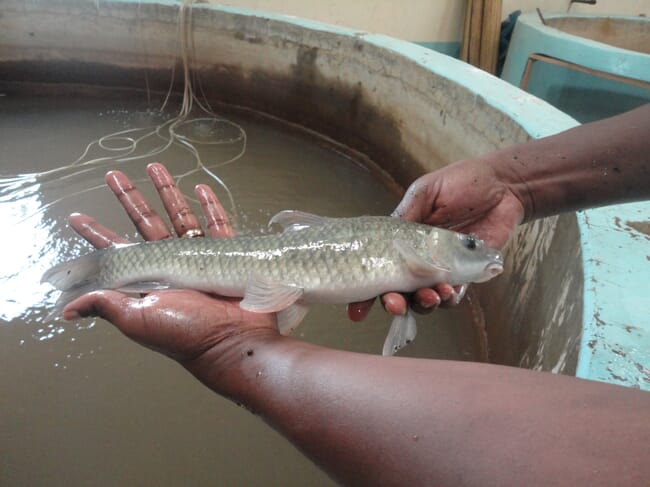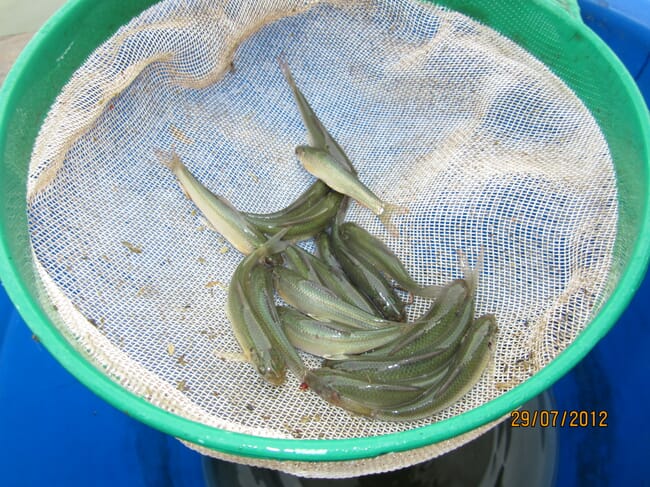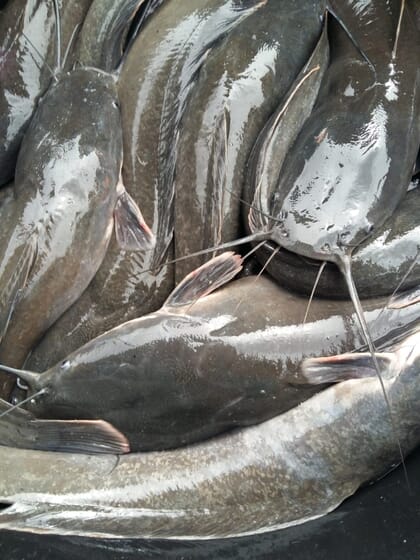
Can you provide a brief summary of your aquaculture career?
I have been involved in aquaculture since 1996, when I joined Kenya Marine and Fisheries Research Institute as a research scientist. At that time, the focus was on breeding for conservation of endangered and threatened species of Lake Victoria and less on farming for food or markets. Among our successes was the breakthrough in breeding the African carp (Labeo victorianus) which I undertook as part of my Master’s degree programme at the Swedish Center for Biodiversity. I served as a national chair of the Aquaculture Development Working Group, whose role was to institute a science-based aquaculture development drive in Kenya.
After leading the transformation of the Sagana centre into the National Aquaculture Research Development and Training Centre, in Kenya, I joined WorldFish Egypt and Nigeria, where the idea of the Fish for Africa Innovation Hub was born. The hub supported capacity building of African countries in aquaculture and, by the time I left, had trained people in over 110 countries worldwide, attracting several partnerships.
Have you played a part in Afraq2021?
I’ve been involved from inception from March 2018 when the director of Central Laboratory for Aquaculture Research (CLAR) and I (representing WorldFish in Egypt) wrote to the World Aquaculture Society requesting the conference. I have been part of the organising committee as the secretary of the African Chapter of WAS. I am also participating in the Afraq21 conference representing the World Bank. I will be presenting a paper entitled “Financing sustainable small and medium scale aquaculture growth In Africa” at the finance and investment session.
What inspired you to become involved in aquaculture?
Since I was young, I have been a fish eater and in our rural village, we fished for some cichlids from local seasonal streams and rivers. Growing up, I noticed first the depletion of this resource and drying up of most of the streams. With no fish left, there were attempts to farm tilapia at our local District Office, but this was unsuccessful due to lack of feed and scarcity of water. So, my inspiration was in trying to make it work and later seeing success among community and individual ventures has spurred me on.

© Harrison Karisa
What’s your proudest achievement in the sector to date?
Seeing the transformation and success among entrepreneurial farmers across the African continent. Of course, this has been a progressive triumph which was defined when in 2007, as programme coordinator, I presented my vision to “put aquaculture on the Kenyan map” to a government delegation led by a minister. This started a move that saw substantial allocation of money to aquaculture development by the government and wider participation of the private sector who, as a result, benefited from the opportunities created by the initial public investment into the sector.
Have you encountered any specific individuals or organisations that we can all learn from?
I have met many interesting individuals and organisations working in this sector. It may not be fair to start mentioning them by name at the risk of leaving out important individuals and groups. I would like, however, to salute the many farmers and hatchery producers who have had to pioneer this work in different countries and sometimes in areas thought to be unsuitable for aquaculture.
The many fish feed producers – both local and international – who have made a serious contribution to providing the much-needed quality fish feeds at affordable prizes deserve a mention too, as well as those entrepreneurs who have supported farmers by providing markets and market logistics.
Many government officials have worked hard to make enabling policies and regulatory frameworks to ensure sustainable environments for development. Aquaculture could not have reached where it is without active participation of a diverse group of youthful innovators, researchers and entrepreneurs who have spent considerable effort in using innovation to solve challenges facing aquaculture. Lastly, recent years have seen a growing interest by financial institutions to fund the sector, despite the dearth of data to support the various investments.
What does a typical day in your current role consist of?
It includes meetings with clients and fellow colleagues working in different countries in the world. We typically discuss technical aspects of new and on-going aquaculture and fisheries projects supported by the bank. This support includes advice on ensuring environmental integrity of projects and application of best aquaculture practice and innovations – especially in line with climate change, and environmental and social safeguards. Where necessary, I review terms of references for different studies and identify suitable candidates for consultancies, and review products and reports for quality control.
What are the most important things you’ve learned about African aquaculture over the years?
Although we have been talking about the potential for aquaculture to develop in Africa for a long time, we are now at the right time for realising this potential. The reasons for dismal performance over the years are well known and are not insurmountable. In the past few years, we have seen a proliferation of serious investments, by both the public and private sector, which has enhanced the provision of quality inputs such as seed and feed, as well as the possibility to engage in more productive systems – like cages, recirculation aquaculture systems (RAS) and aquaponics.

© Harrison Karisa
Also, aquaculture has been accompanied by innovations in terms of the use of mobile telephony to share technical information and market intelligence among farmers, increased use of water quality monitoring gadgets for pond management, as well as the use of novel ingredients such as insect meal and other locally available plant-based feed sources, to replace more expensive fish meal and emerging diversification of aquaculture products.
With the right mix of policy and investment, African aquaculture has begun to take its rightful place as a viable alternative to capture fisheries. Egypt, where aquaculture supplies 80 percent of its fish requirements, is a good example of what can happen.
What are the key challenges Africa has to overcome to fulfil its aquaculture potential?
Africa’s key challenges include the lack of affordable quality inputs, especially seed and feed, and dependence on a few species for aquaculture (currently Nile tilapia and African catfish account for over 95 percent of harvests), despite the many species with farming potential in the continent.

Other issues include the lack of technical knowhow among aquaculture practitioners in Africa, inadequate policy and regulatory frameworks supporting the sector growth, threats of climate change and biosecurity, inadequate public and private expenditure on aquaculture development due to negative publicity and the lack of champions.
There is also an inadequate application of local solutions, and a lack of information and data to influence decision makers and financial institutions.
Do you think technology, especially climate-smart technology, has an important role to play in the development of the sector in Africa?
Indeed, Africa has also seen an awakening and of technological advancement that has been borne in the African continent. A good example is the use of mobile networks to share knowledge, and collection of data. Others include recirculation aquaculture systems, in-pond raceway systems, cage aquaculture, the use of non-fed species – such as seaweeds and some shellfish – and the use of insect meals to replace fishmeal in aquafeeds.
Which species and regions do you think have the greatest potential for the sustainable growth of the sector?
Africa has been known to produce farmed tilapia and catfish across the continent. Nile tilapia (Orechromis niloticus) and African catfish (Clarias gariepinus) are likely to continue dominating freshwater aquaculture. Other widely farmed tilapias include three-spotted tilapia, blue tilapia and Mozambique tilapia.
However, mariculture species are emerging in coastal areas – with species produced including breams, snappers, shrimps, seaweed, oysters, seabass and milkfish. However, the fish with highest potential for sustainable growth will be those that do not require feeding or at least can do without expensive fish feeds – such as carp, oysters, seaweeds and tilapia. Tilapia is a diverse group and most promising also because they can tolerate a wide range of salinities, although they cannot do very well in colder regions.
How do you see the sector evolving over the next decade? And beyond that?
I see aquaculture continuing to grow due to increased demand for seafood amidst stagnating fisheries and a growing population and middle class. Increased application of climate-smart aquaculture technologies, intensification and increased productivity will continue in the short- and medium-term. Expansion into new water bodies and the marine environment – using cage aquaculture, and offshore mariculture techniques – is likely to increase, with better and improved inputs. We are also likely to increase the intensification of pond systems, energy-efficient RAS, aquaponics and other resilient culture systems.
The sector is also likely to see more species diversification and aquaculture becoming the main source of fish for Africans. This will be accompanied by more investment in quality-oriented post-harvest handling and value-added aquaculture products in the next decades and beyond.
If you could solve one challenge in African aquaculture what would it be?
The biggest challenge is lack of knowledge and experience among practitioners. This is a serious challenge in undertaking selective breeding programmes, running hatcheries and the management of farms. Sorting this capacity challenge is a key priority, and it’s vital to provide both young and female entrepreneurs with affordable credit, to enable them to put what they have learnt into practice. This challenge will be resolved through both public and private investment targeted at building the necessary institutional capacities.




